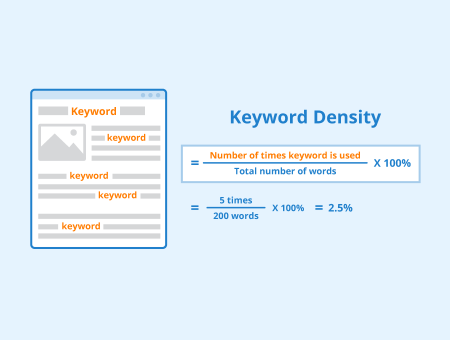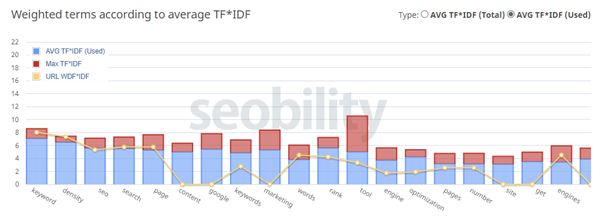Keyword density
Keyword density, also called keyphrase density, is the percentage of words on a page that match a keyword. Keyword density can provide a rough indication of how important a word is on a page, or how well a page is optimized for a certain word or phrase, by showing the percentage of words on the page that match the keyword.
Although keyword density used to be an important part of SEO, it reduced in importance as search engines added more ranking factors and improved on those they were using. This led various alternatives to keyword density to be created by SEOs, which were often a lot more complex.
The history of keyword density
In the early days of search engines, things like term frequency and keyword density were key ranking factors. By adding more keywords to your page, you could easily spam your way to the top of SERPs. However, as search engines started cracking down on spam and adding more ranking factors to improve the results shown to their users, simplistic on-page SEO factors like keyword density and term frequency lost some of their effectiveness.
Over the years, as search engines became better at understanding webpages and search intent, keyword variations and related words also grew in importance. This has led to many different, often more complex, forms of keyword density being favored by SEOs. Although keyword density is still considered to have its place in SEO, the way it is used has changed considerably. It is now used as more of an indication of relevance, rather than something to base your on-page optimization on.
Various tools have been created to gauge the importance of words in a text, most of which use different, often more complex methods, like TF*IDF. These tools seem to have differing levels of effectiveness but are generally regarded as more effective than basic keyword density.
How is keyword density calculated?
Keyword density is calculated by dividing the number of times a keyword can be found on the page by the total number of words on a page, multiplied by 100. This gives you the keyword density percentage.
For example, if we have a page with 2000 words that contains a given keyword 50 times, the keyword density is (50/2000)x100 = 2.5%
What’s the ideal keyword density?
Although average keyword density percentages seen across search are sometimes recommended, it is generally accepted that the ideal keyword density varies per search term, and that it is more important to write for users rather than for search engines or to achieve a certain level of keyword density. This has led most on-page SEO tools including our own to tailor the recommendation to the keyword you’re trying to rank for.
These tools look at the pages that rank in the SERPs for a given keyword and then provide you with indications of how many times you should add or remove a keyword based on the pages that already rank for it. This provides you with an ideal keyword density for a specific search result instead of a generalization based on averages across the whole search landscape.
An image of our TF*IDF Tool that uses a variation of keyword density called TF-IDF based on the SERPs.
Its relevance to SEO
Keyword density is still relevant to SEO in various ways, even though it is generally accepted that writing for visitors is more important than trying to achieve a certain keyword density. It can be used to find the most important keywords on a page, as well as give you an indication as to how often you should use a keyword on your page.
However, various more advanced variations of pure keyword density have been created, which are used by various SEO tools. An example is TF*IDF, which is used by our own on-page TF*IDF tool.
These methods are generally considered more effective in the SEO community since search engines use much more than just keyword density in their algorithms.
Over the past few years, search engines have also gotten a lot better at understanding search intent as well as content on pages, further taking focus away from keyword density and instead focusing on what words and phrases actually mean, instead of solely focusing on exact match keywords.
Related links
- https://www.researchgate.net/publication/262852700_Keyword_stuffing_and_the_big_three_search_engines
- https://www.business2community.com/seo/10-keyword-density-checkers-and-how-they-still-can-help-your-seo-02189398


